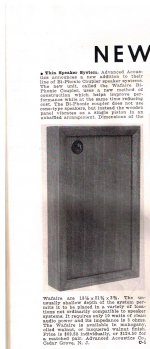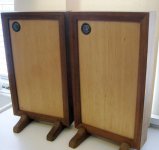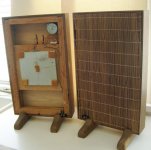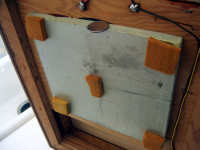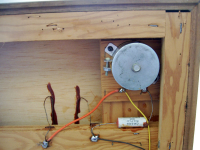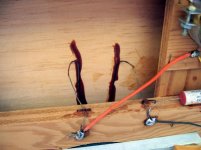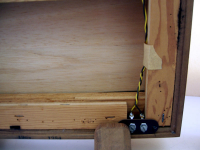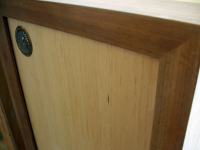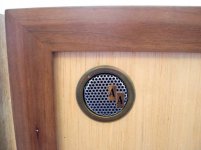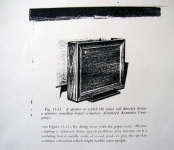Anyone ever attempted to reproduce this form of speaker? Apparently it's a wood panel piston-ic action driver with a helper tweeter. Produced by a company called Advanced Acoustics. It was termed a bi-phonic coupler.
Advanced Acoustics Vintage Audiophile Speakers - YouTube
In the March 1962 issue of Audio..Page 60 "New Products" I found a short description and picture.
But I am intrigued about how this puppy works exactly. Any ideas? The fact this seems to work at all is amazing to me and with all that old 60s and 70s rec room paneling out there in suburbia screaming to be torn out and re-purposed, the raw cone material (if I can call it that) for this type of implementation seems readily available...knotty-pine, pecan, ranch-style etc etc. Gives the term "wall o' sound" a new dimension, doesn't it?😉
For reasons that defy my comprehension🙄this loudspeaker system didn't seem to take the audio world by storm at the time...yet I admire the sheer unmitigated chutzpah..and wonder if it could be improved upon...
After all, who would have thunk that foam board could be used to make suitable enclosures and gasp! horns?
Comments, observations, conjecture? Would love to hear SpeakerDave's take on this design😀
Advanced Acoustics Vintage Audiophile Speakers - YouTube
In the March 1962 issue of Audio..Page 60 "New Products" I found a short description and picture.
But I am intrigued about how this puppy works exactly. Any ideas? The fact this seems to work at all is amazing to me and with all that old 60s and 70s rec room paneling out there in suburbia screaming to be torn out and re-purposed, the raw cone material (if I can call it that) for this type of implementation seems readily available...knotty-pine, pecan, ranch-style etc etc. Gives the term "wall o' sound" a new dimension, doesn't it?😉
For reasons that defy my comprehension🙄this loudspeaker system didn't seem to take the audio world by storm at the time...yet I admire the sheer unmitigated chutzpah..and wonder if it could be improved upon...
After all, who would have thunk that foam board could be used to make suitable enclosures and gasp! horns?
Comments, observations, conjecture? Would love to hear SpeakerDave's take on this design😀
Attachments
Last edited:
Both the front panel and rear panel flexed by virtue of the voice coil being fixed to the front and the magnet to the back panel.Hence, in the descriptive title of 'Bi Phonic Coupler".The only reason I can think of why it did not become popular was it needed bass boosting to equalise the falling L.F. response caused by the lack of compliance caused by the very small internal volume.This needed care to achieve good results and it may have been difficult with contemporary amplifiers.I believe it was designed by an American audio pioneer,Abraham B.Cohen.
So slap an exciter to any object that will vibrate and I've got a loudspeaker of some sort?
Both the front panel and rear panel flexed by virtue of the voice coil being fixed to the front and the magnet to the back panel.Hence, in the descriptive title of 'Bi Phonic Coupler".The only reason I can think of why it did not become popular was it needed bass boosting to equalise the falling L.F. response caused by the lack of compliance caused by the very small internal volume.This needed care to achieve good results and it may have been difficult with contemporary amplifiers.I believe it was designed by an American audio pioneer,Abraham B.Cohen.
Now that's interesting VaNarn! It seemed to me to be a little more than the exciter simply affixed to some form of vibrating membrane.
It's intriguing to me to ponder none the less, particularly given the various harmonic qualities of particular woods...I'm thinking spruce, mahogany, birch etc. ie: as used in guitar, violin, piano soundboard constructions.
I wonder how a suspension system was implemented along the perimeter of the panel or does it depend more upon vibration rather than any excursive qualities?..although the advert does describe the panel operation as a pistonic...some how this reminds me of the Yamaha Ear speakers of the early 70s which utilized a solid Styrofoam driver with minimal excursive qualities...
Since the Yamaha ear speaker has been mentioned the offset drive position of the coil and the non uniform shape were part of the design approach to minimise resonance.The large effective area meant that excursion is relatively small.The "coupler" acts as a monopole speaker with the excursion being shared between front and rear panels,the gain is in virtually twice the effective area.Perhaps if someone knows how the internals of the speaker were constituted it would help in understanding how unwanted signals were suddued and how the vibrating sections were fitted.
Since the Yamaha ear speaker has been mentioned the offset drive position of the coil and the non uniform shape were part of the design approach to minimise resonance.The large effective area meant that excursion is relatively small.The "coupler" acts as a monopole speaker with the excursion being shared between front and rear panels,the gain is in virtually twice the effective area.Perhaps if someone knows how the internals of the speaker were constituted it would help in understanding how unwanted signals were suddued and how the vibrating sections were fitted.
Yes, I would love to see a shot of the internal construction or even see a diagram of how that might work...
I once had the crazy idea to cut a large hole in a door, fix model aircrft mylar to the space, and cannibalise a woofer for the motor and coil. Never got around to trying it. Of course, enclosing the rear would present bass issues, and chances are OB operation would work almost as well.
I once had the crazy idea to cut a large hole in a door, fix model aircrft mylar to the space, and cannibalise a woofer for the motor and coil. Never got around to trying it. Of course, enclosing the rear would present bass issues, and chances are OB operation would work almost as well.
Stop giving me ideas mondog...😀..but seriously I wonder how the motor coil suspension of this wood panel speaker was designed and implemented. Boy it's times like this that a picture really would be worth a thousand words.
Now I think about it, Im sure ive seen a drawing or custom 'conventional' dynamic panel speaker integral to the enclosure. It used several large bar magnets and a circumferential coil. (is that a word?) the coil ran around the whole diaphragm about a fifth the way in from the edge. There was no real suspension, i think it was just compliantly mounted using felt or foam buffers.
Last edited:
There's some more info on these here...VanNarn's comments about Abraham Cohen of University Loudspeakers fame being behind these is correct.
Upon second look at the video
Advanced Acoustics Vintage Audiophile Speakers Acoustics Vintage Audiophile Speakers
Featuring one of these wood panel loudspeakers the rear of the unit appears not to be a solid panel, but more like a woven bamboo curtain..which intrigues me even more as I thought the rear and front panels would be working in concert together somehow...the video makes it appear as if these were definitely not sealed but a type of OB.
I found a little (emphasis on "little") more info on these here:
Billboard - Google Books
Upon second look at the video
Advanced Acoustics Vintage Audiophile Speakers Acoustics Vintage Audiophile Speakers
Featuring one of these wood panel loudspeakers the rear of the unit appears not to be a solid panel, but more like a woven bamboo curtain..which intrigues me even more as I thought the rear and front panels would be working in concert together somehow...the video makes it appear as if these were definitely not sealed but a type of OB.
I found a little (emphasis on "little") more info on these here:
Billboard - Google Books
If it's not just a motor stuck to a panel (like the "tactile transducers" already mentioned), it must be something much like the pre-ribbon Magnepans, which of course work much better 🙂.
If it's not just a motor stuck to a panel (like the "tactile transducers" already mentioned), it must be something much like the pre-ribbon Magnepans, which of course work much better 🙂.
Nope, definitely not just a motor stuck to a panel....how did these pre-ribbon Magnepans work?
See pictures of the quasi-ribbon on this page: Planar theoryhow did these pre-ribbon Magnepans work?
There's some more info on these here...VanNarn's comments about Abraham Cohen of University Loudspeakers fame being behind these is correct.
Upon second look at the video
Advanced Acoustics Vintage Audiophile Speakers Acoustics Vintage Audiophile Speakers
Featuring one of these wood panel loudspeakers the rear of the unit appears not to be a solid panel, but more like a woven bamboo curtain..which intrigues me even more as I thought the rear and front panels would be working in concert together somehow...the video makes it appear as if these were definitely not sealed but a type of OB.
I found a little (emphasis on "little") more info on these here:
Billboard - Google Books
There is some kind of virus in Your first link. I am unable to Close the page,
Finally some detailed pics on these
Lifted these pics from E-Prey...that give us a much better glimpse in to what was going on inside these wood panel Bi-Phonic speakers...😀😀😀
Wood(sic) love to see what's going on under neath that rectangular cake pan!
Lifted these pics from E-Prey...that give us a much better glimpse in to what was going on inside these wood panel Bi-Phonic speakers...😀😀😀
Wood(sic) love to see what's going on under neath that rectangular cake pan!
Attachments
Last edited:
I'm still thinking conventional motor stuck to a board...
IMO nope!...otherwise why the need for the baking pan cover? And it looks as if there are some kind of leads affixed directly to the front panel.
I have the feeling that once put together,the means of re-opening would have been a mystery.In the pictures presented so far,it seems that the original rear panel has been pried away if the black strips(rubber or felt) were what held it in position.The leads to the front panel are the voice coil leads and I would think the magnet is compliantly mounted in the sub-frame in such away that it can be aligned with the v.c. but be reasonably free to to move back and forth.A mechanical crossover system is suggested by the 5 foam pads that are spaced on the magnet rear surface and these would have driven the original rear panel.The bamboo 'thing' appears to be a ring in.
- Status
- Not open for further replies.
- Home
- Loudspeakers
- Multi-Way
- Wood panel piston-ic speaker
